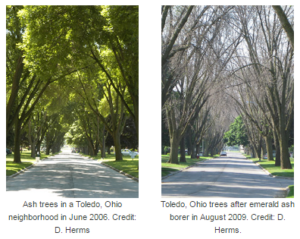Ash Trees in Jeopardy, EAB is here
By Melanie Stewart
The Emerald Ash Borer (EAB) has been confirmed in Douglas and Cass Counties, forcing quarantines and treatment zones to be enacted in Douglas, Sarpy, Cass, Saunders, Lancaster, Washington, Dodge, Pottawattamie, and Mills counties. It is an invasive beetle that whose larvae bore into the layer of wood beneath the bark, which is responsible for water and nutrient movement in the tree, and this eventually kills the tree. Once an area is infested, it’s estimated that 80% of ash trees will be killed in the first 8 years.
Omaha has an estimated 100,000 ash trees, all of which could be wiped out by an EAB infestation. This will remove 14% of Omaha’s tree canopy and change the landscape of our city, while increasing air-conditioning costs. To help spread awareness, the Omaha Parks Foundation and City of Omaha Forestry Division have participated in EAB Awareness Week for several years. Ironically, this is how the EAB was discovered. Several trees have been wrapped with bright emerald ribbons to show what’s at risk. This includes several trees on campus.

While we have a diverse species of trees on campus, almost every tree lining Emile and Farnam Streets on the 42nd and Dewey campus are ash trees, including the trees the purple martins use in their migration. Almost all of the trees lining Regency Parkway, Abbot Drive, and along the streets of Memorial and Elmwood parks are ash trees.
Not only will we lose the trees and the benefits they provide, but removal of the dead trees will cost millions of dollars. EAB has killed hundreds of millions of ash trees in the U.S. since its discovery in 2002.
So what can you do to stop the devastation?
- Educate yourself on EAB, identify ash trees in your area, educate others.
- Observe the quarantine preventing the movement of firewood, mulch, timber, and green waste as beetles and larvae can hide, be transported, and infect other areas.
- Plant more trees now.
- Plant diverse species to protect against future loss.
- More than 60 species of broadleaf trees can be grown successfully in eastern Nebraska.
Are you a homeowner with an ash tree?
- Remove ash trees in poor condition.
- Treat healthy ash trees to slow down the spread of EAB.
- Spray and soil applications are available; talk to a certified arborist.
- Plant more trees now.
- Plant diverse species to protect against future loss.
